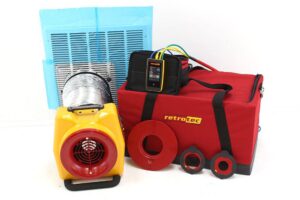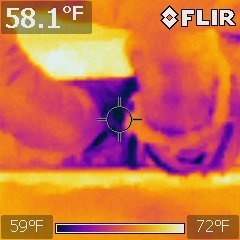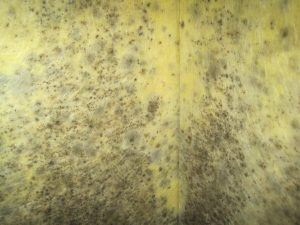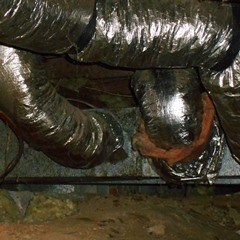What is Duct Pressure Testing and Why Does It Matter?
Duct pressure testing is a diagnostic procedure performed by a certified professional that measures the air tightness of a home’s duct system. One of the things that we do – both in upgrades of existing homes as well as in new construction – is duct pressure testing of the system(s). In existing homes, we usually seal duct work as part of energy efficient upgrades, so we use a blower door and a pressure pan to check each of the registers (or “supply vents”) to ensure each is sealed to less than 1 pascal. In new construction, we test duct work to make sure it meets that area’s requirements for the Energy Code; this is measured in CFM (cubic feet per minute) per 1,000SF (square feet). For this test (a formal “Duct Pressure Test”), we seal supply and return registers with grill mask or vent caps, and we use a calibrated fan to pressurize or depressurize the duct system through one of the central returns. Then, a manometer connected to the fan measures pressure differences between the fan and a reference point in a supply line of the duct system. The manometer gives a reading of the Cubic Feet per Minute at a pressure of 25 pascals (or “CFM25”), and we use that number to calculate the percentage of leakage.

Most areas of Alabama either require new homes to have less than 12% leakage (2009 Code) or less than 4% leakage (2015 Code). The average existing home’s duct leakage is about 20-30% (before we properly seal the system)! These leakage points (in new and existing systems) are usually around register boots where the supply lines enter the conditioned space of the home, joints between supply lines and trunk lines, seams along trunk lines, and connection points around the air handler.

Frequently, your home’s duct system resides outside of the “thermal boundary” or outside of conditioned spaces (either in the attic or a basement/crawlspace). If your ducts are not properly sealed or leak, then you may as well be throwing your hard earned money out the window – or rather into your crawlspace or attic. Without a sealed duct system, the money and energy it takes to heat or cool your home gets wasted, and you do not receive the comfort you expect. Alternatively, sometimes a duct system is inside the thermal boundary (inside conditioned space). This is ideal because even if the ducts leak, the conditioned air is leaking inside your conditioned area. In this situation, however, occupants may still find some rooms are not the same/desired temperature as others. Sealing the system can help remedy uneven heating and cooling.
Leaking ducts not only waste money and decrease comfort, but also they can lead to mold inside the duct system. Condensation forms when cool air meets warm air, so when a duct system is carrying warm air that leaks into a cold basement the result is condensation and sometimes eventually mold. Not all moldy systems need to be completely replaced; they can sometimes be cleaned and treated to prevent mold regrowth.

In conclusion, a duct system is an extremely important component of a home’s HVAC (heating, ventilation, air conditioning) system meant to transfer conditioned (heated or cooled) air to various rooms. If it is leaking and not properly sealed, you are paying to heat and cool unconditioned parts of your home…and you may be sacrificing comfort at the same time. Stay comfortable and save money with duct pressure testing and a properly sealed duct system. Call us today to have your system checked and for a quote to seal it; call 205-314-3500 for Birmingham and surrounding areas, or call 251-615-1330 for the Gulf Coast and surrounding areas.

